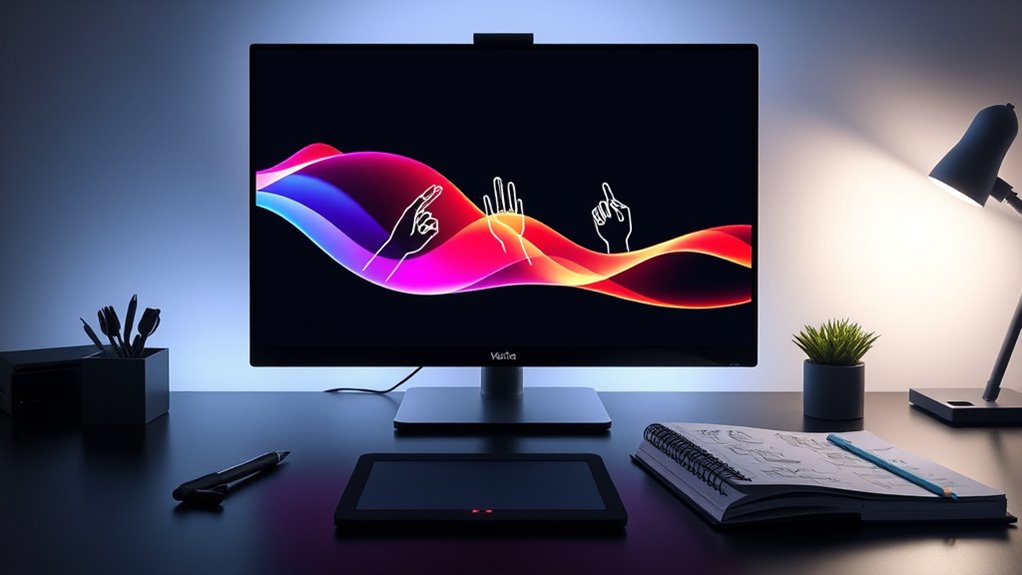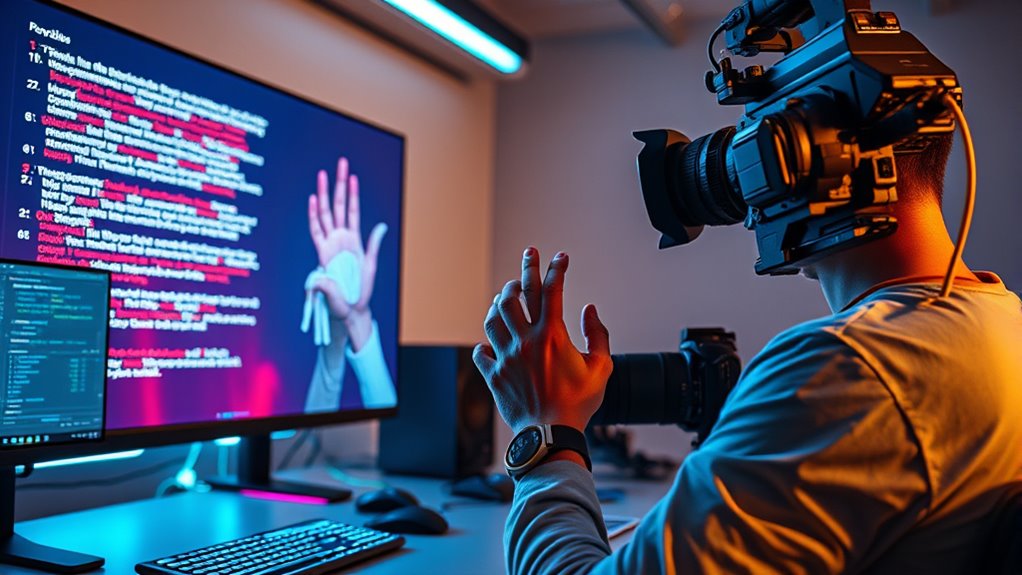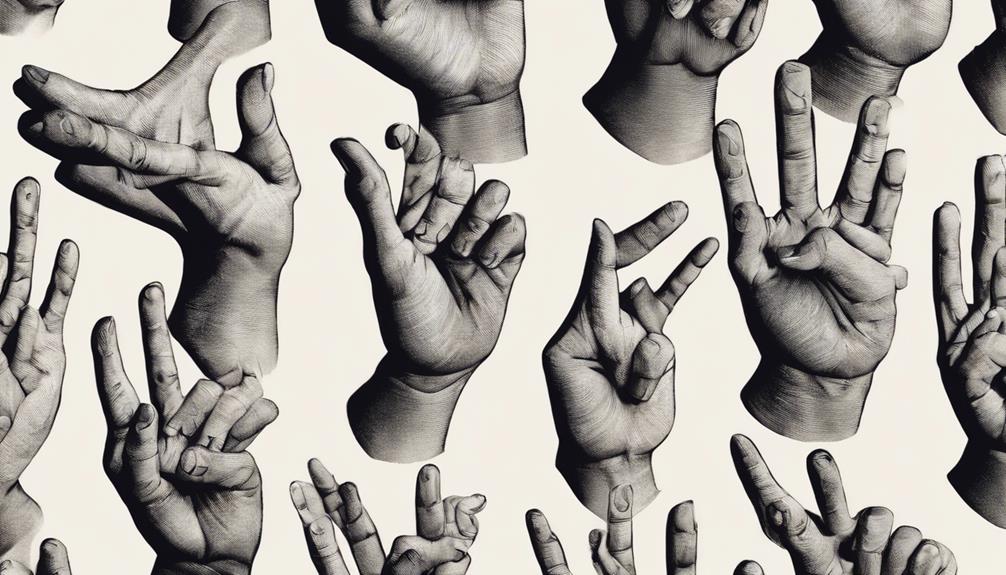To transform text into sign language animations, the technology pipeline combines gesture recognition and motion capture. First, gesture recognition algorithms analyze your input text and identify the appropriate signs. Then, motion capture records human signing motions, capturing finger positions and hand movements. These motions are applied to digital models, creating realistic, expressive signing visuals. If you explore further, you’ll discover how these technologies work together to make sign language communication more accessible and natural.
Key Takeaways
- Text input is analyzed by gesture recognition algorithms to determine corresponding sign language gestures.
- Machine learning models interpret linguistic structure and finger positioning for accurate sign translation.
- Motion capture technology records human signing motions, capturing gestures with high fidelity.
- Captured motions are applied to digital avatars to produce realistic, expressive sign language animations.
- The entire pipeline enables seamless, real-time conversion from written text to sign language visuals.

Text to Sign Animation is transforming how we communicate by turning written words into dynamic sign language visuals. This innovative technology bridges the gap between spoken or written language and sign language, making information more accessible. At the heart of this transformation are advanced tools like gesture recognition and motion capture, which work together to create realistic and expressive sign language animations.
Gesture recognition is the foundational element in converting text into sign language. It involves sophisticated algorithms that interpret human movements and hand gestures, translating them into digital signals. When you input text, the system analyzes the linguistic structure and determines the corresponding signs. Gesture recognition ensures that each sign is accurately identified and mapped, capturing subtle nuances such as finger positioning, hand orientation, and movement flow. This technology relies heavily on machine learning models trained on vast datasets of sign language gestures, enabling it to recognize a wide array of signs with high precision. As a result, the system can generate sign language visuals that are both accurate and natural, closely mimicking real-life signing.
Gesture recognition interprets human movements to produce accurate, natural sign language visuals through advanced algorithms and machine learning.
Motion capture plays an essential role in bringing these digital signs to life. Unlike simple animations, motion capture records real human movements, often using sensors or cameras to track hand and body positions. When creating sign language animations, motion capture captures the intricate motions involved in signing—fast finger movements, fluid hand transitions, and expressive gestures. These captured motions are then applied to digital models, resulting in sign language visuals that are highly realistic and expressive. This process allows for a more authentic representation of sign language, which is indispensable for effective communication, especially for those who rely on sign as their primary language. Motion capture also accelerates the animation process, reducing the time needed to produce high-quality sign language videos, and guarantees consistency across different animations.
Together, gesture recognition and motion capture form a seamless pipeline that converts plain text into expressive sign language visuals. The gesture recognition system interprets the linguistic content and determines the appropriate signs, while motion capture ensures those signs are animated with lifelike realism. This synergy allows for efficient, accurate, and engaging sign language content, making communication more inclusive. As these technologies continue to evolve, expect even more natural, real-time sign language translation tools that can serve deaf communities and improve accessibility across various media platforms. Additionally, the development of vetted and reliable datasets enhances the accuracy of gesture recognition systems, further advancing this field. This pipeline is not just about technological innovation; it’s about creating a more connected and inclusive world where language barriers are steadily broken down through the power of advanced animation.
Frequently Asked Questions
How Accurate Is Automated Sign Language Translation?
Automated sign language translation’s accuracy depends on gesture recognition technology and quality sign language datasets. You might find it helpful, but it’s not perfect yet, especially with complex signs or varied gestures. The better the datasets and the more advanced the gesture recognition, the more reliable the translation. Still, some nuances and context can be missed, so human verification remains essential for critical communication.
Can Sign Animations Adapt to Regional Dialects?
You might wonder if sign animations can adapt to regional dialects and cultural nuances. The answer is yes, but it’s complex. Developers are working to incorporate regional dialects into sign language animations, making them more accurate and relatable. They do this by customizing movements and signs based on local variations. While progress is ongoing, fully capturing all regional differences remains a challenge, but future updates will improve cultural nuance adaptation.
What Are the Limitations of Current Sign Language AI?
Think of sign language AI as a map with many uncharted territories. Its main limitations lie in gesture recognition, which struggles with subtlety and speed, and cultural adaptation, where it can’t fully grasp regional dialects or context. These gaps mean the technology often misses nuances and variations, making it hard for AI to accurately interpret or replicate diverse sign language expressions across different communities.
How Secure Is User Data During Sign Animation Processing?
You might wonder how secure your data is during sign animation processing. Privacy concerns are valid, but most systems use data encryption to protect your information from unauthorized access. Developers implement strict security measures to guarantee your data remains confidential throughout the process. While no system is entirely foolproof, these encryption techniques and privacy protocols substantially minimize risks, giving you confidence that your sensitive information stays protected during sign language animation.
Will Sign Animation Technology Replace Human Interpreters?
You might wonder if sign animation technology will replace human interpreters. While it advances sign language pedagogy and promotes cultural inclusivity, technology can’t fully capture the nuance and emotional connection interpreters provide. You’ll find it’s a helpful supplement, especially in accessible communication, but human interpreters remain essential for complex, culturally sensitive conversations. So, rather than replacing them, expect it to enhance and support their crucial role.
Conclusion
Now that you understand the tech pipeline behind text-to-sign animation, you’re witnessing a breakthrough that’s transforming communication forever. This innovation doesn’t just change how we share information—it’s like giving a voice to the silent, making the impossible possible. As this technology continues to evolve at lightning speed, you’re on the front lines of a revolution that could redefine connection itself. Get ready—because the future of inclusive communication is happening right now, and you’re part of it.











